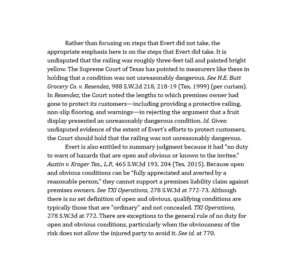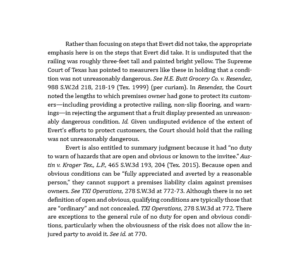Here are 4 missed opportunities for persuasion that I see in persuasive legal writing. In each situation, the substance is strong, but the placement isn’t. Because I’m focusing on placement—the location of key content within a paragraph—I’ve used nonsense text so you won’t be distracted or bored reading long paragraphs. Just focus on the green, highlighted text.
1. Missed chance: Relegating a forceful concept from a case to an explanatory parenthetical buried in mid-paragraph.
In pretium lorem sed elit rutrum maximus. Nullam venenatis semper est, et luctus est aliquam at. Vestibulum tempor vitae neque et volutpat. Maecenas commodo laoreet nulla vel porta. Fusce iaculis tortor ut pulvinar eleifend. Ut auctor risus a vehicula efficitur. Flake v. Adams, 123 S.W.3d 456, 458 (Tex. 2011) (recognizing equitable adoption as valid in Texas). In gravida, turpis et ornare gravida, orci quam vulputate urna, id tincidunt lectus ex pulvinar dolor. Proin ac tortor sapien. Sed maximus in sapien quis dignissim. Cras ut leo sed odio maximus euismod ac sed erat.
1a. Why not state the forceful concept in the first sentence and then cite the case, omitting the explanatory parenthetical? (Assuming the concept is actually forceful and important—not merely background.)
The Texas Supreme Court recognizes that equitable adoption is valid in Texas. Flake v. Adams, 123 S.W.3d 456, 458 (Tex. 2011). In pretium lorem sed elit rutrum maximus. Nullam venenatis semper est, et luctus est aliquam at. Vestibulum tempor vitae neque et volutpat. Maecenas commodo laoreet nulla vel porta. Fusce iaculis tortor ut pulvinar eleifend. Ut auctor risus a vehicula efficitur. In gravida, turpis et ornare gravida, orci quam vulputate urna, id tincidunt lectus ex pulvinar dolor. Proin ac tortor sapien. Sed maximus in sapien quis dignissim. Cras ut leo sed odio maximus euismod ac sed erat.
2. Missed chance: Relegating a forceful quotation from a case to an explanatory parenthetical.
In pretium lorem sed elit rutrum maximus. Nullam venenatis semper est, et luctus est aliquam at. Vestibulum tempor vitae neque et volutpat. Maecenas commodo laoreet nulla vel porta. Fusce iaculis tortor ut pulvinar eleifend. Ut auctor risus a vehicula efficitur. Flake v. Adams., 123 S.W.3d 456, 458 (Tex. 2011) (“Equitably adopted children have the same inheritance rights as biological children.”) In gravida, turpis et ornare gravida, orci quam vulputate urna, id tincidunt lectus ex pulvinar dolor. Proin ac tortor sapien. Sed maximus in sapien quis dignissim. Cras ut leo sed odio maximus euismod ac sed erat.
2a. Why not state the forceful quotation in the first sentence and then cite the case, omitting the explanatory parenthetical? (Assuming the quotation is actually forceful and important—not merely background. And if it’s merely background, why quote it?)
The Texas Supreme Court acknowledges that “[e]quitably adopted children have the same inheritance rights as biological children.” Flake v. Adams, 123 S.W.3d 456, 458 (Tex. 2011). In pretium lorem sed elit rutrum maximus. Nullam venenatis semper est, et luctus est aliquam at. Vestibulum tempor vitae neque et volutpat. Maecenas commodo laoreet nulla vel porta. Fusce iaculis tortor ut pulvinar eleifend. Ut auctor risus a vehicula efficitur. In gravida, turpis et ornare gravida, orci quam vulputate urna, id tincidunt lectus ex pulvinar dolor. Proin ac tortor sapien. Sed maximus in sapien quis dignissim. Cras ut leo sed odio maximus euismod ac sed erat.
3. Missed chance: Constructing a descriptive, explanatory paragraph that builds to a concluding statement of a legal doctrine or concept.
In pretium lorem sed elit rutrum maximus. Nullam venenatis semper est, et luctus est aliquam atus. Gomez v. Gomez, 234 S.W.3d 567, 570 (Tex. 2012). Vestibulum tempor vitae neque et volutpat. Maecenas commodo laoreet nulla vel porta. Fusce iaculis tortor ut pulvinar eleifend. Flake v. Adams, 123 S.W.3d 456, 458 (Tex. 2011). Ut auctor risus a vehicula efficitur. In gravida, turpis et ornare gravida, orci quam vulputate urna, id tincidunt lectus ex pulvinar dolor. Proin ac tortor sapien. Sed maximus in sapien quis dignissim. Bradley v. Kang, 343 S.W.3d 282, 289 (Tex. 2013). Cras ut leo sed odio maximus euismod ac sed erat. Consequently, Texas common law recognizes promise and performance as the elements of equitable adoption.
3a. Why not begin the paragraph with the statement, describe and explain, and then reiterate the doctrine or concept at the end?
Texas common law recognizes promise and performance as the elements of equitable adoption. In pretium lorem sed elit rutrum maximus. Nullam venenatis semper est, et luctus est aliquam atus. Gomez v. Gomez, 234 S.W.3d 567, 570 (Tex. 2012). Vestibulum tempor vitae neque et volutpat. Maecenas commodo laoreet nulla vel porta. Fusce iaculis tortor ut pulvinar eleifend. Flake v. Adams, 123 S.W.3d 456, 458 (Tex. 2011). Ut auctor risus a vehicula efficitur. In gravida, turpis et ornare gravida, orci quam vulputate urna, id tincidunt lectus ex pulvinar dolor. Proin ac tortor sapien. Sed maximus in sapien quis dignissim. Bradley v. Kang, 343 S.W.3d 282, 289 (Tex. 2013). Cras ut leo sed odio maximus euismod ac sed erat, thus supporting promise and performance as the elements of equitable adoption.
4. Missed chance: Building an argument with legal analysis and concluding the paragraph with the key assertion.
In pretium lorem sed elit rutrum maximus. Nullam venenatis semper est, et luctus est aliquam at. Vestibulum tempor vitae neque et volutpat. Maecenas commodo laoreet nulla vel porta. Fusce iaculis tortor ut pulvinar eleifend. Ut auctor risus a vehicula efficitur. Flake v. Adams, 123 S.W.3d 456, 458 (Tex. 2011). In gravida, turpis et ornare gravida, orci quam vulputate urna, id tincidunt lectus ex pulvinar dolor. Maecenas vel eros quis sem porta pellentesque eget quis neque. Phasellus pretium eros ac vestibulum tincidunt. Pellentesque non dui maximus tortor tristique tempor vel sollicitudin leo. Proin ac tortor sapien. Sed maximus in sapien quis dignissim. Cras ut leo sed odio maximus euismod ac sed erat. Therefore, Chris Jaramillo should be awarded an equal share of the estate of Ron Jaramillo.
4a. Why not begin the paragraph with the key assertion, use legal analysis to support that position, and then reiterate the assertion at the end?
Chris Jaramillo should receive an equal share of the estate of Ron Jaramillo. In pretium lorem sed elit rutrum maximus. Nullam venenatis semper est, et luctus est aliquam at. Vestibulum tempor vitae neque et volutpat. Maecenas commodo laoreet nulla vel porta. Fusce iaculis tortor ut pulvinar eleifend. Ut auctor risus a vehicula efficitur. Flake v. Adams, 123 S.W.3d 456, 458 (Tex. 2011). In gravida, turpis et ornare gravida, orci quam vulputate urna, id tincidunt lectus ex pulvinar dolor. Maecenas vel eros quis sem porta pellentesque eget quis neque. Phasellus pretium eros ac vestibulum tincidunt. Pellentesque non dui maximus tortor tristique tempor vel sollicitudin leo. Proin ac tortor sapien. Sed maximus in sapien quis dignissim. Cras ut leo sed odio maximus euismod ac sed erat, confirming that Chris Jaramillo should be awarded an equal share of Ron Jaramillo’s estate.




